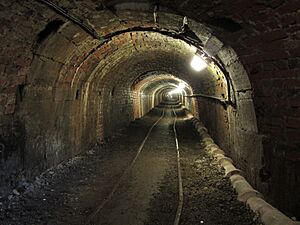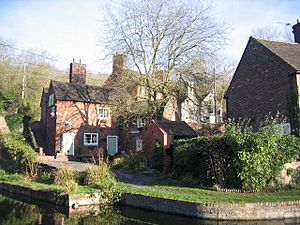Tar Tunnel facts for kids
The Tar Tunnel is an old tunnel located on the north side of the River Severn in the Ironbridge Gorge at Coalport, England. It is one of the ten Ironbridge Gorge Museums attractions. These museums are managed by the Ironbridge Gorge Museum Trust.
A Sticky Discovery
In 1787, miners were digging a tunnel for the Coalport Canal. They were trying to connect the canal to coal mines under the Blists Hill area. Suddenly, they hit a gushing spring of natural bitumen. This substance is a thick, black, sticky liquid, a bit like treacle or tar.
The original plan was to build a canal tunnel. This idea was suggested by William Reynolds. However, after digging about 3,000 feet (914 meters) into the hill, the canal project was stopped. Instead, people focused on collecting the natural bitumen. A special track for wagons was built in the tunnel by 1796. This track helped remove coal from the mines.
The Tar Tunnel became a very interesting place in the 1700s. Even today, bitumen still slowly oozes from its brick walls. Back then, bitumen was mainly used to protect ropes and seal wooden ships from water. Small amounts were also bottled and sold as 'Betton's British Oil'. People believed this oil could cure many illnesses, like rheumatism and scurvy.
After the canal tunnel project was abandoned, another clever solution was built. This was the Hay Inclined Plane. It was a special railway that moved boats up and down a hill. Its base was right next to where the canal basin would have been.
The tunnel was used for commercial purposes until 1941. After that, it was briefly used as an air raid shelter during wartime. Then, it was completely left alone for a while.
Exploring the Tunnel
In 1965, members of the Shropshire Mining Club explored the tunnel. They managed to go about 2,100 feet (640 meters) inside. Two years later, in 1967, the Dawley District Council bought the tunnel. They worked to make the first 295 feet (90 meters) safe for visitors. In 1974, the coal board cleared another 607 feet (185 meters).
In the past, visitors could enter the first 300 feet (91 meters) of the brick-lined tunnel. They were given hard hats and could walk as far as an iron gate. Electric lights helped them see inside. However, it is now unsafe to enter the tunnel fully. This is because of a build-up of gas. But visitors can still look into the tunnel from the entrance and see part of its length.
Tunnel Structure
The Tar Tunnel is about 0.6 miles (1 kilometer) long. The first 59 feet (18 meters) of the tunnel have a double layer of bricks. A single layer of bricks continues for another 820 feet (250 meters). After that, there is a long section of about 1,378 feet (420 meters) that has no brick lining. Then, the tunnel becomes narrower, about 3 feet (0.9 meters) wide, and the brick lining returns. There is also a second tunnel that branches off the main one about 1,184 feet (361 meters) from the entrance.



